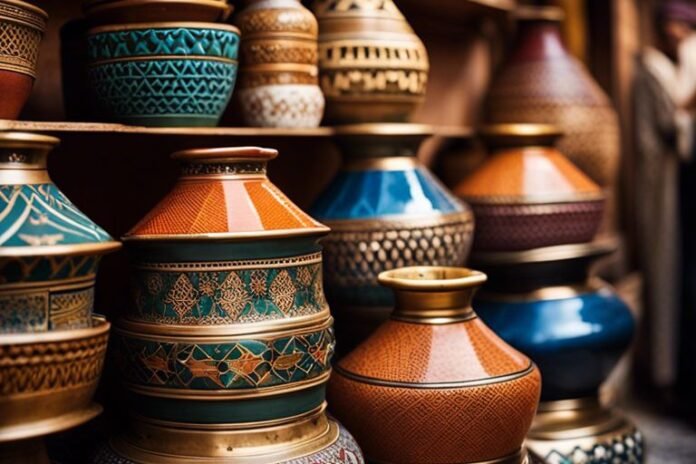Craft enthusiasts and cultural connoisseurs alike will appreciate the rich history and artistic traditions that flourish in Fez, Morocco. Renowned as the country’s vibrant hub of craftsmanship, Fez is a treasure trove of artisanal wonders waiting to be explored. From delicate pottery and intricate tile work to sumptuous textiles and exquisite leather goods, the city’s skilled artisans have been honing their craft for centuries, passing down their techniques from generation to generation. To probe deeper into the fascinating world of Fez’s crafts, one can wander through the bustling souks, where the air is filled with hammering, weaving, and chiseling, creating a sensory experience like no other.
Visiting this enchanting city is a must for those intrigued by the allure of Fez’s artistic heritage. The distinctiveness of Fez’s crafts lies in the meticulous attention to detail and the time-honored traditions woven into each handmade piece. Whether admiring the colorful patterns of Zellige tilework, marveling at the intricacy of handwoven textiles, or haggling for a beautifully crafted leather bag, Fez offers a captivating glimpse into Morocco’s flourishing arts and crafts scene.
To learn more about the fascinating craft traditions of Fez and immerse yourself in the city’s vibrant cultural tapestry, consider launching on a guided tour or exploring the historic medina on your own. For further reading on Fez’s artisanal wonders, check out Explore The Luminous Birthplace Of Morocco’s Many Arts …
Key Takeaways:
- Tilework: Fez is renowned for its exquisite ceramic and tilework, known as Zellige, which adorn many buildings and palaces in the city.
- Leather Goods: The city is famous for its leather tanneries, producing high-quality leather goods such as bags, shoes, and jackets.
- Textiles: Fez is a hub for producing traditional Moroccan textiles, including rugs, carpets, and fabrics made from silk and wool.
- Woodwork: Skilled artisans in Fez craft intricate wooden furniture, screens, and carvings using traditional techniques passed down through generations.
- Metalwork: The city is also known for its intricate metalwork, including lanterns, tea sets, and other decorative items made from brass, copper, and silver.
- Calligraphy: Fez is a center for Islamic calligraphy, with artisans creating beautiful designs on surfaces such as paper, ceramics, and metal.
- Pottery: The city boasts a long history of pottery making, with artisans producing colorful ceramics adorned with traditional geometric patterns and motifs.
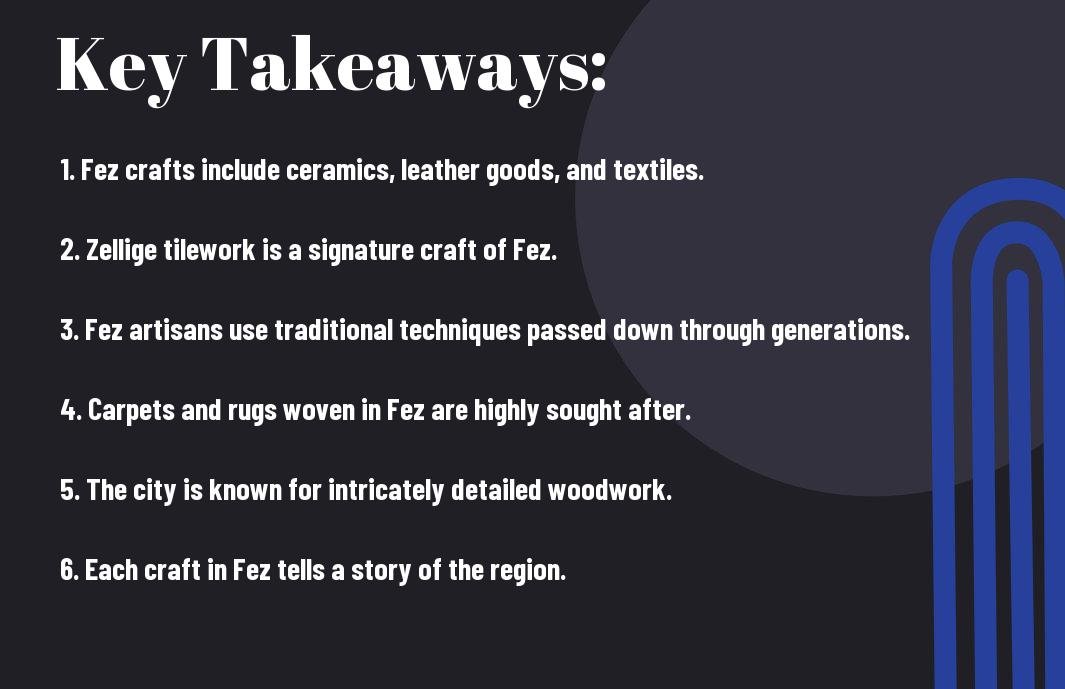
The Leather Legacy
Fez, the cultural heart of Morocco, has long been known for its rich tradition of leather craftsmanship. The skill and artistry of leather artisans in this ancient city have been passed down through generations, creating a leather legacy that is admired worldwide.
The Tanning Process in the Chouara Tannery
On the outskirts of the medina lies the Chouara Tannery, the oldest and most famous tannery in Fez. Here, the centuries-old leather tanning tradition continues, with artisans using natural methods to dye and soften the hides.
The tanning process involves meticulous steps, from soaking the hides in vats of natural dyes to drying them under the Moroccan sun. The sight of the colorful vats and the pungent smell of the tannery create a sensory experience like no other.
Crafting of Leather Goods
Leather goods crafted in Fez are renowned for their quality and exquisite craftsmanship. Skilled artisans transform the tanned hides into various products, including bags, shoes, and decorative items.
Artisans use traditional tools and techniques to create these leather goods, often embellishing the pieces with intricate designs and patterns. Each item is a labor of love, reflecting the artisan’s dedication to preserving Fez’s leather heritage.
The Art of Zellige in Leatherwork
To infuse a touch of Moroccan elegance into their leather goods, artisans often incorporate the art of Zellige into their designs. Zellige, a form of mosaic tilework, adds a unique aesthetic to the leather pieces, making them true works of art.
This fusion of Zellige and leatherwork showcases the ingenuity and creativity of Fez’s artisans, who draw inspiration from their city’s rich architectural heritage. Zellige’s intricate patterns and vibrant colors bring a sense of sophistication to the leather goods.
Modern Challenges and Sustainability
Chouara Tannery and other leather workshops in Fez face modern challenges in maintaining their centuries-old practices while ensuring sustainability. Environmental concerns and economic pressures threaten the traditional leather industry in the city.
To address these challenges, efforts are being made to modernize the tanning process, adopt eco-friendly practices, and support fair trade initiatives. Balancing tradition with innovation is critical to preserving Fez’s leather legacy for future generations.
The Intricacies of Metalwork
Brass and Copper Crafting Techniques
After centuries of honing their craft, artisans in Fez have perfected the techniques of brass and copper crafting. These metals are transformed into exquisite pieces of art using traditional methods passed down through generations. Skilled artisans meticulously shape and mold the materials, often employing intricate designs and patterns to create stunning works of art.
For artisans in Fez, brass and copper crafting is a labor of love that requires patience, precision, and a deep understanding of the properties of the metals. From intricate filigree work to elaborate engravings, each piece is a testament to the artisans’s dedication and skill.
Artistic Expressions in Metal
Metal in Fez goes beyond mere craftsmanship; it is a medium for artistic expression. Artisans take great pride in pushing the boundaries of traditional metalwork, creating avant-garde pieces that blend traditional techniques with contemporary design. These artists infuse their creations with a sense of creativity and innovation that sets them apart.
With a keen eye for detail and a deep appreciation for the beauty of metal, artisans in Fez experiment with new forms, textures, and finishes to create truly unique pieces that capture the essence of Moroccan artistry. Each creation tells a story of tradition and innovation, showcasing the endless possibilities of metal as an artistic medium.
With a history dating back centuries, metalwork in Fez has evolved into a thriving industry that continues to uphold the city’s reputation for excellence in craftsmanship. The metalwork tradition is deeply rooted in Fez’s cultural heritage and significantly shapes the city’s identity as a center for artistic expression and creativity.
The Role of Metalwork Guilds
To ensure the preservation of traditional metalworking techniques and promote the growth of the craft, metalwork guilds in Fez play a vital role in nurturing the next generation of artisans. These guilds serve as hubs of knowledge and expertise, providing aspiring artisans with the resources and training needed to master the art of metalwork.
Through apprenticeships and mentorship programs, metalwork guilds in Fez pass on valuable skills and techniques and instill a sense of pride and belonging in the artisan community. By upholding standards of excellence and fostering collaboration, these guilds contribute to metalwork’s continued success and advancement in Fez.
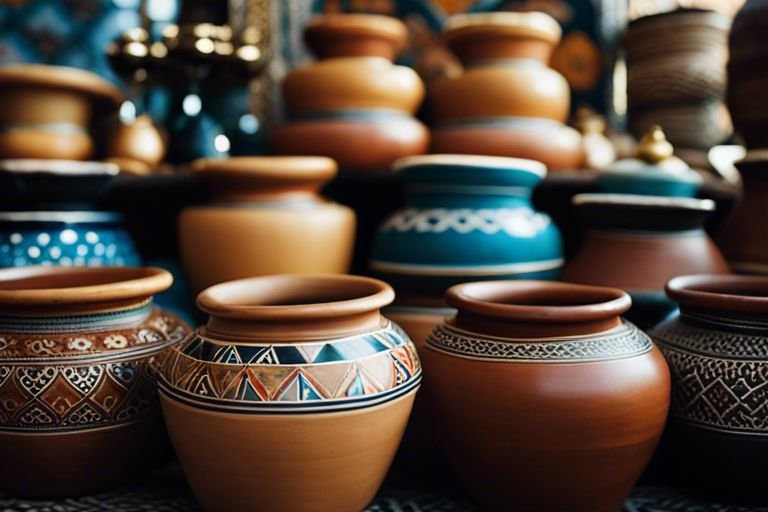
The Weaving Wonders of Fez
Now, let’s research the intricate world of textile production in Fez, a city renowned for its weaving wonders.
The History of Textile Production
The art of weaving in Fez dates back centuries, with a rich history rooted in tradition and craftsmanship. Textile production has long been a significant part of the city’s cultural heritage, with weavers passing down their skills from generation to generation.
Over the years, Fez has become synonymous with delicate fabrics and intricate designs, attracting admirers from far and wide who appreciate the artistry and skill of creating these beautiful textiles.
Different Forms of Weaving
Visitors to Fez will be captivated by the diverse forms of weaving throughout the city. From the intricate patterns of Berber carpets to the delicate silk fabrics, there is no shortage of weaving styles to admire.
Forms of weaving in Fez can range from the traditional methods used by local artisans to more contemporary approaches that blend modern techniques with traditional craftsmanship. Each piece tells a story, reflecting the weaver’s cultural influences and artistic vision.
Silk Weaving: A Dying Art?
Dying silk threads have long been a specialty of Fez weavers, known for their expertise in creating luxurious fabrics that shimmer in the light. However, this traditional art form risks fading as modern technologies and changing consumer preferences challenge its sustainability.
Weaving enthusiasts and preservationists are working tirelessly to ensure that the intricate techniques and cultural significance of silk weaving are not lost to future generations. It is essential to raise awareness about the importance of protecting these age-old traditions before it’s too late.
The Importance of Natural Dyes
Weaving in Fez is not just about the skillful manipulation of threads but also about using natural dyes that give the textiles their distinct colors and vibrancy. Artisans in Fez have perfected the art of dyeing fabrics using organic natural materials, creating a sustainable and environmentally friendly way of producing textiles.
This dedication to using natural dyes adds to the uniqueness of Fez’s textiles and supports the preservation of traditional methods passed down through generations. It is a testament to the commitment of Fez weavers to honor their craft and the environment.
The Beauty of Fez Ceramics
To truly appreciate the rich tradition of ceramics in Fez, one must research the intricate and exquisite world of Fez ceramics. Renowned for their detailed craftsmanship and vibrant colors, Fez ceramics have captivated art enthusiasts and collectors for centuries.
Earthenware and Pottery Techniques
For centuries, artisans in Fez have perfected the art of earthenware and pottery making, passing down their techniques from generation to generation. The clay used in Fez ceramics is sourced locally, giving each piece a unique connection to the region’s rich artistic heritage. Skilled artisans use traditional methods to shape, glaze, and fire the pottery, resulting in stunning pieces showcasing creativity and craftsmanship.
Intricate patterns and designs are meticulously painted by hand onto the pottery before the final firing process, adding a touch of individuality to each piece. The rich cultural history of Fez is intricately woven into every ceramic creation, making each piece an actual work of art.
The Art of Zellige Tile Making
With a history dating back to the 10th century, the art of Zellige tile making is a hallmark of Fez ceramics. Intricate geometric patterns are meticulously crafted using colorful ceramic tiles, creating mesmerizing mosaics that adorn the walls and floors of mosques, palaces, and homes throughout Fez.
Pottery is vital in Moroccan culture, and Zellige tile-making is no exception. Hand-cutting and assembling the tiny tiles requires immense skill and precision, resulting in awe-inspiring masterpieces that showcase the beauty of Islamic art and architecture.
Contemporary Ceramic Artists
Fez’s ceramic tradition continues to thrive in the hands of contemporary ceramic artists who blend age-old techniques with modern influences. These artists push the boundaries of traditional ceramic art, creating innovative and visually striking pieces that appeal to a global audience.
Techniques such as raku firing and experimental glazing methods are employed by contemporary ceramic artists in Fez, adding a new dimension to the city’s ceramic scene. These artists draw inspiration from their surroundings, infusing their creations with a modern twist while staying true to the rich cultural heritage of Fez.
The Delicate Art of Embroidery
Despite being known for its vibrant pottery and intricate tilework, Fez also boasts a rich embroidery tradition that has been practiced for centuries. This delicate art form holds a special place in the city’s cultural heritage, reflecting a blend of different influences that have shaped its unique styles and techniques.
Historical Roots of Fez Embroidery
Delicate and detailed, Fez embroidery is steeped in history, with roots tracing back to medieval times when the city flourished as a center of art and culture. Influenced by various civilizations that once ruled the region, including the Arab, Berber, and Andalusian cultures, Fez embroidery carries a distinct timeless and intricate aesthetic.
Over the years, Fez embroidery has evolved, incorporating elements from various traditions to create a distinctly Moroccan style. From geometric patterns to floral motifs, each stitch tells a story of the city’s rich past and the skilled hands that have passed down this art form through generations.
Styles and Techniques
On a closer look, Fez embroidery is characterized by its attention to detail and precision. Artisans often use silk threads in vibrant colors to create intricate patterns that adorn textiles, garments, and accessories. Techniques such as cross-stitching, chain stitching, and satin stitching are commonly employed to achieve the desired effect.
Fez embroidery can transform any fabric, whether a traditional caftan, a decorative pillowcase, or a modern clothing item. The versatility of this art form allows for endless possibilities, making it a popular choice for both traditional and contemporary designs.
The Integration of Embroidery in Modern Fashion
An essential component of Moroccan fashion, Fez embroidery has found its way into the global market, with designers from around the world incorporating its intricate designs into their collections. The artistry and craftsmanship of Fez embroidery add a touch of elegance and sophistication to any garment, making it a sought-after embellishment for those who appreciate fine craftsmanship.
To truly appreciate the art of Fez embroidery is to understand the skill and dedication that goes into each stitch. As this ancient tradition continues to thrive in the modern world, it serves as a testament to this delicate art form’s enduring beauty and cultural significance.
The Craft of Woodworking
For centuries, woodworking has been a revered craft in Fez, Morocco. Skilled artisans create intricate and beautiful pieces using traditional techniques and tools. The craft of woodworking in Fez is not only a means of livelihood but also a form of art that is deeply embedded in the city’s cultural heritage.
Artisanal Carving Methods
To create exquisite woodwork pieces, artisans in Fez employ a variety of carving methods that have been passed down through generations. One common technique is relief carving, where intricate designs are carefully carved into the wood to create a three-dimensional effect. Another popular method is intaglio carving, where the design is carved below the surface of the wood.
Artisans in Fez also use techniques like chip carving, where small chips of wood are removed to create geometric patterns and scroll sawing, a delicate method that allows for intricate fretwork designs. These techniques require high skill and precision, showcasing the mastery of Fez’s woodworkers.
Types of Wood Used in Fez
Any woodworking discussion in Fez would be incomplete without mentioning the types of wood artisans commonly use. The choice of wood plays a significant role in the final aesthetic and durability of the piece. Artisans in Fez often work with various kinds of wood, each chosen for its unique characteristics and suitability for different projects.
- Cedar
- Walnut
- Lemonwood
- Olive wood
- Rosewood
After selecting the appropriate wood for a project, artisans in Fez pay meticulous attention to every detail, ensuring that the final piece reflects the beauty and richness of the chosen material.
Iconic Wood Products
Methods
Woodworking in Fez produces a wide range of iconic wood products that are highly sought after for their craftsmanship and beauty. One of the most famous products is the intricately carved wooden furniture that adorns homes and palaces across the city. From ornate tables and chairs to exquisite cabinets and doors, these pieces showcase the artistry and skills of Fez’s woodworkers.
Materials
In addition to furniture, woodworking in Fez also produces decorative items such as wooden boxes, intricate screens, and delicate ornaments. These products often feature traditional Moroccan motifs and patterns, adding a touch of elegance to any space. Using high-quality wood and intricate carving techniques ensures that each piece is a work of art in its own right.
The Essence of Moroccan Mosaic
Unlike many Western mosaic traditions, Moroccan mosaics have a distinct style and technique passed down through generations, particularly in Fez. The craftsmanship behind Moroccan mosaics is truly a sight to behold, showcasing intricate patterns and vibrant colors that mesmerize the beholder.
The Craftsmanship Behind Mosaic Designs
Designs for Moroccan mosaics are meticulously planned and executed by skilled artisans who have honed their craft over years of practice. These craftsmen carefully chip and shape individual tiles, known as Zellige, to create geometric patterns and floral motifs characteristic of Moroccan mosaic art.
Each mosaic design is a unique masterpiece, with every tile placed by hand to form a stunning composition. The precision and attention to detail required in creating these intricate patterns highlight the dedication and skill of the artisans behind these mesmerizing works of art.
The Role of Mosaics in Moroccan Architecture
Behind the ornate walls and ceilings of Moroccan palaces and mosques lies a rich history of mosaic artistry that dates back centuries. Mosaics play a significant role in Moroccan architecture, adorning the interiors and exteriors of buildings with breathtaking designs that reflect the country’s cultural heritage.
For instance, the famous Moroccan courtyard gardens, such as those found in the Alhambra Palace, feature intricate mosaic fountains and pathways that add a touch of elegance and beauty to the surroundings. These mosaics not only serve a decorative purpose but also convey symbolic meanings that are deeply rooted in Moroccan traditions and beliefs.
Preservation of Mosaic Techniques
Mosaic techniques in Morocco have been preserved through ongoing efforts to safeguard traditional craftsmanship and promote the art form to future generations. Skilled artisans continue to pass down their knowledge and techniques, ensuring that the intricate art of Moroccan mosaics remains alive and thriving.
A testament to the enduring legacy of Moroccan mosaics, contemporary artists and designers also draw inspiration from traditional techniques to create modern interpretations that fuse the old with the new, bridging the gap between past and present in a harmonious blend of artistic innovation.
Jewelry and Adornments
Traditional Jewelry Techniques in Fez
Keep in mind that Fez has a rich tradition of crafting intricate jewelry using age-old techniques that have been passed down through generations. Artisans in Fez are known for their expertise in creating stunning pieces using methods such as filigree, engraving, and gem setting. These techniques require high skill and precision, making Fez a hub for exquisite handmade jewelry.
Artisans in Fez often work with precious metals such as gold and silver and vibrant gemstones like turquoise, coral, and amber. These materials are carefully selected and skillfully incorporated into the designs to create unique and eye-catching pieces that showcase the beauty of Moroccan craftsmanship.
Significance of Jewelry in Moroccan Culture
For centuries, jewelry has held a special place in Moroccan culture, symbolizing status, wealth, and cultural identity. In Moroccan society, jewelry is not just an accessory but a reflection of one’s heritage and social standing. It is common for both men and women to wear jewelry to express their individuality and celebrate their cultural roots.
To truly appreciate the significance of jewelry in Moroccan culture, one must understand the intricate symbolism behind each piece. From intricate motifs symbolizing protection and prosperity to gemstones believed to bring luck and ward off evil spirits, Moroccan jewelry is steeped in tradition and meaning.
Culture: Jewelry-making in Fez is not just a craft but a cultural practice that connects the past with the present. Each piece of jewelry carries a history and meaning that reflects the cultural values and beliefs of the Moroccan people. Whether worn for special occasions or as part of everyday attire, jewelry in Fez serves as a testament to this ancient city’s rich heritage and artistry.
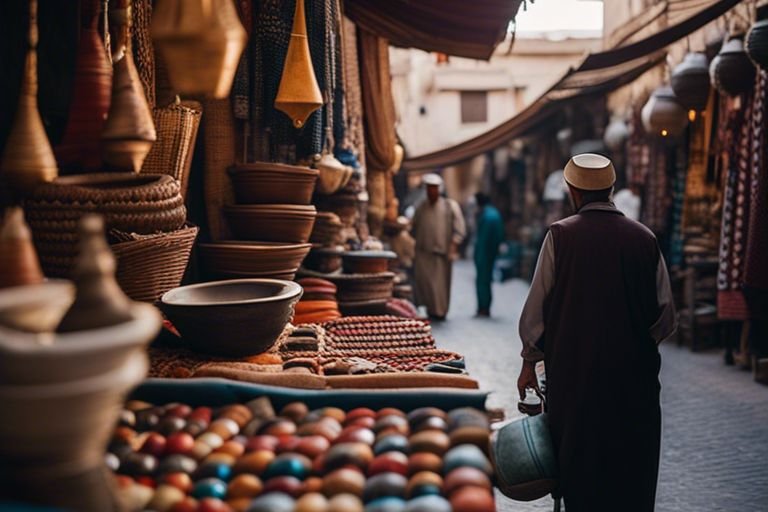
The Role of Crafts in Fez’s Tourism
Your The Fez Craft Scene, The Best In The World blog post explores the significance of crafts in Fez, not just as a cultural tradition but also as a critical driver of tourism in the city. Fez’s rich history of craftsmanship has attracted visitors from around the globe who are eager to witness the skill and artistry of local artisans.
Souks and Markets: Shopping for Authentic Souvenirs
Fez’s vibrant souks and markets are a treasure trove for those seeking authentic Moroccan crafts. From intricately patterned textiles to handcrafted ceramics and leather goods, visitors can find many souvenirs to take home. The bustling alleyways of the medina are filled with stalls showcasing Fez’s finest craftsmanship.
Exploring the souks is not just about shopping; it’s also a cultural experience that allows visitors to immerse themselves in the heritage of Fez. The markets’ sights, sounds, and smells provide a sensory overload that is truly unique to this ancient city.
Artisanal Tours and Workshops
Tours of artisanal workshops offer a behind-the-scenes look at how traditional crafts are made in Fez. Visitors can witness skilled artisans using techniques passed down through generations. These tours provide a deeper appreciation for the time and effort of creating each piece.
Any visitor to Fez interested in crafts should consider participating in a workshop to try their hand at making something themselves. Whether it’s weaving a carpet, shaping pottery, or dyeing fabric, these hands-on experiences offer a unique insight into Moroccan craftsmanship.
Future Outlook for Fez Artisans
Not only does Fez boast a rich history of craftsmanship, but it also looks toward the future with a sense of innovation and resilience. For those interested in delving deeper into the crafts of Fez, exploring Crafts of Fez – Visit Fez City – Fès can provide valuable insights into the intricate artistry of this city.
Challenges Facing the Crafts Industry
One of the main challenges facing the crafts industry in Fez is the competition from mass-produced goods that flood the market. Artisans often struggle to compete with cheaper, factory-made products that lack the authenticity and quality of handcrafted items. Additionally, limited access to markets and resources can hinder the growth and sustainability of traditional craft practices.
Prospects for Innovation and Adaptation
Adaptation is critical for Fez artisans to thrive in a rapidly changing marketplace. By incorporating modern design trends while preserving traditional techniques, artisans can attract new consumers interested in unique, handcrafted products. Embracing technology for marketing and e-commerce can also help artisans reach a wider audience and increase their visibility in the global market.
Prospects for innovation and adaptation in Fez’s crafts industry are promising. As artisans collaborate with designers, entrepreneurs, and government initiatives, they can explore new opportunities for growth and sustainability. By leveraging their cultural heritage and creativity, Fez artisans can position themselves as leaders in the global artisanal market.
The Impact of Globalization and Modernity
Challenges posed by globalization and modernity present both opportunities and threats to Fez’s traditional crafts. While increased connectivity and access to international markets can expose artisans to new ideas and trends, it also raises concerns about cultural appropriation and the preservation of authenticity. Maintaining a balance between traditional craftsmanship and contemporary demands is crucial for the long-term viability of Fez’s artisanal industry.
This delicate balance requires careful navigation by artisans, policymakers, and consumers to ensure that Fez’s crafts continue to flourish in a rapidly changing world. By fostering a deeper appreciation for the time-honored techniques and cultural significance of Fez’s crafts, stakeholders can work together to preserve and elevate this critical aspect of the city’s heritage.
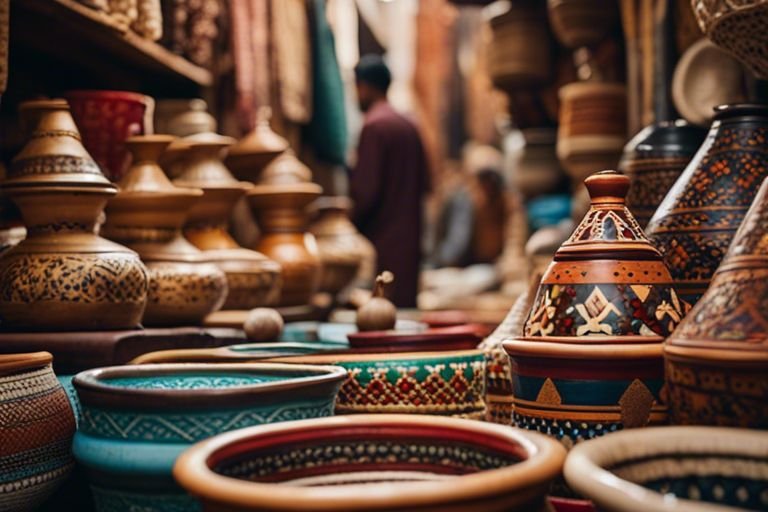
Conclusion
On the whole, Fez is renowned for its rich history of craftsmanship and artisanal traditions, producing a wide array of beautiful and intricate crafts. The city is especially famous for its exquisite pottery, leather goods, textiles, and metalwork. Each craft reflects centuries-old techniques passed down through generations, contributing to Fez’s reputation as a hub of creativity and skill.
Visitors to Fez can witness talented artisans in the city’s bustling souks and workshops, where they can purchase unique handcrafted items as souvenirs. The crafts made in Fez not only showcase the city’s cultural heritage but also serve as a vital economic lifeline for many local artisans. From the pottery’s vibrant colors to the textiles’ intricate patterns, Fez’s crafts continue to captivate and inspire art lovers and travelers worldwide.
FAQ
Q: What crafts are traditionally made in Fez?
A: Traditional crafts made in Fez include intricate handwoven carpets, colorful ceramics, delicate metalwork, and fine leather goods.
Q: What is Fez known for in terms of craftsmanship?
A: Fez is renowned for its exquisite pottery, elaborate wood carving, beautiful embroidery, and unique tile work.
Q: Are there specific artisanal techniques used in crafting in Fez?
A: Yes, artisans in Fez often employ age-old techniques such as Zellige (mosaic tile work), tadelakt (polished plaster), and hand-painted ceramics to create their masterpieces.
Q: How are traditional crafts in Fez preserved and passed down through generations?
A: The transmission of knowledge and skills in traditional crafts in Fez occurs through apprenticeships within families and artisan guilds, ensuring that these techniques are preserved and perpetuated.
Q: Where can visitors to Fez purchase authentic handmade crafts?
A: Visitors can find authentic handmade crafts in Fez at the famous souks (markets) such as Souk el Attarine and Souk Seffarine, as well as in boutique shops and artisan cooperatives throughout the city.
Q: Are there any special events or festivals in Fez that showcase traditional crafts?
A: Yes, the Fez Festival of Sufi Culture and the World Sacred Music Festival in Fez often feature exhibitions, workshops, and performances highlighting traditional crafts and artisanal skills.
Q: Can visitors to Fez learn and participate in crafting workshops?
A: Yes, there are many opportunities for visitors to Fez to engage in crafting workshops and hands-on experiences, where they can learn from skilled artisans and create their unique pieces to take home as souvenirs.

